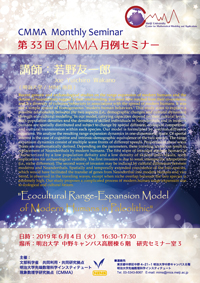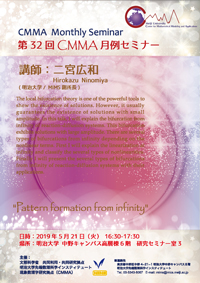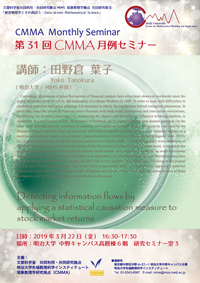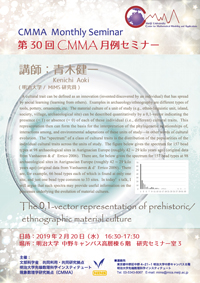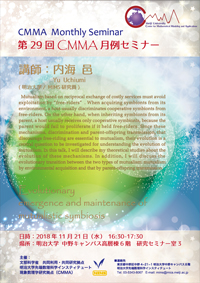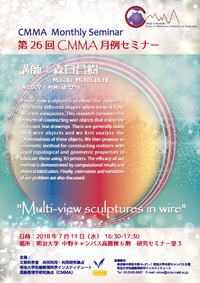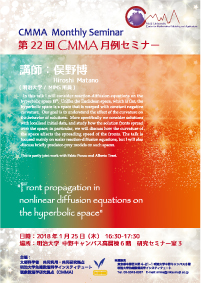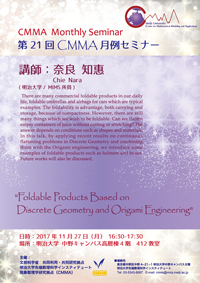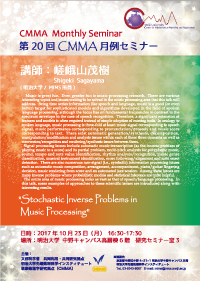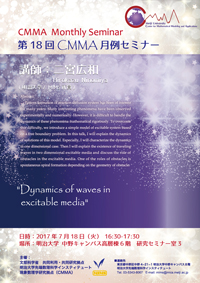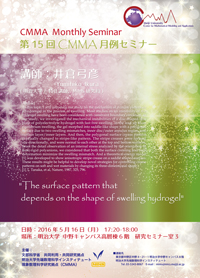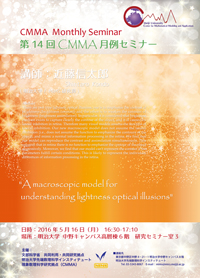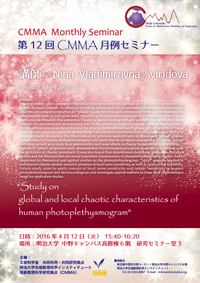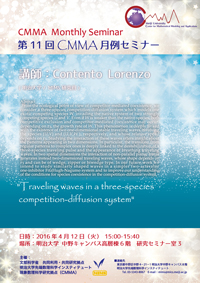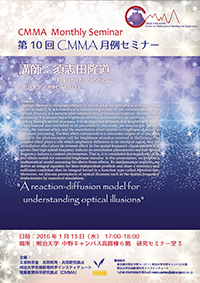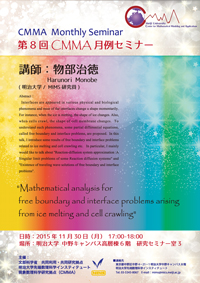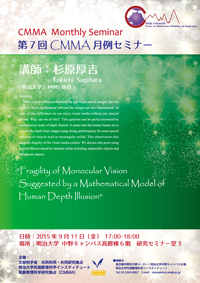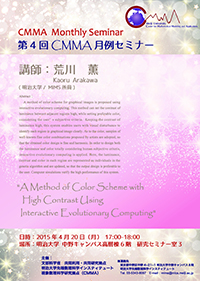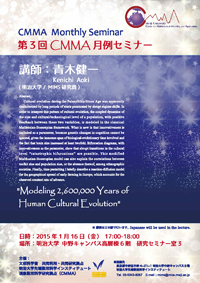- HOME
- > セミナー・イベント一覧
- > CMMA月例セミナー
CMMA月例セミナー
CMMA月例セミナー
| 主催 | 共同利用・共同研究拠点 明治大学先端数理科学インスティテュート(MIMS) 「現象数理学拠点」 |
|---|---|
| 中野キャンパス へのアクセス |
|
| 中野キャンパス マップ |
講演は日本語で行われます。 The seminar will be lectured in Japanese.
第33回CMMA月例セミナー
- 日時 :
- 2019年6月4日(火) 16:30~17:30
- 場所 :
- 明治大学 中野キャンパス高層棟6階 研究セミナー室3
- 講師:
- 若野友一郎 (Joe Yuichiro Wakano)
(明治大学/ MIMS所員)
-
Title:
"Ecocultural Range-Expansion Model
of Modern Humans in Paleolithic"
Abstract:
Recent genetic and archaeological studies on the range expansion of modern humans and the demise of Neanderthals suggest 1) their interbreeding, that must have resulted from their co-existence, and 2) a diversity of cultures/behaviors in associations with the spread of modern humans. It was not a simple spread of homogeneous "modern human behaviors." This study aims to explain a possible relationship between the two aspects (i.e., demographic changes and cultural dynamics) through eco-cultural modeling. In our model, carrying capacities depend on their cultural levels. Both population densities and the densities of skilled individuals in Neanderthals and in modern humans are spatially distributed and subject to change by spatial diffusion, ecological competition, and cultural transmission within each species. Our model is formulated by reaction-diffusion equations. We analyze the resulting range expansion dynamics in one-dimensional space. Of special interest is the case of cognitive and intrinsic-demographic equivalence of the two species. The range expansion dynamics consist of multiple wave fronts of different speeds. Properties of these wave fronts are mathematically derived. Depending on the parameters, these traveling waves can result in replacement of Neanderthals by modern humans. The first wave of intrusive modern humans is characterized by a low population density and a low density of skilled individuals, with implications for archaeological visibility. The first invasion is due to weak interspecific competition (i.e., niche difference). The second wave of invasion may be induced by cultural differences between moderns and Neanderthals. Spatially and temporally extended coexistence of the two species, which would have facilitated the transfer of genes from Neanderthal into modern humans and vice versa, is observed in the traveling waves, except when niche overlap between the two species is extremely high. Our study proposes a complicated process of modern human range-expansion due to ecological and cultural factors.
第32回CMMA月例セミナー
- 日時 :
- 2019年5月21日(火) 16:30~17:30
- 場所 :
- 明治大学 中野キャンパス高層棟6階 研究セミナー室3
- 講師:
- 二宮広和 (Hirokazu Ninomiya)
(明治大学/ MIMS副所長)
-
Title:
"Pattern formation from infinity"
Abstract:
The local bifurcation theory is one of the powerful tools to show the existence of solutions.However, it usually guarantees the existence of solutions with small amplitude.In this talk, I will explain the bifurcation from infinity of reaction-diffusion systems.This bifurcation exhibits solutions with large amplitude.There are several types of bifurcations from infinity depending on the nonlinear terms.First I will explain the linearization at infinity and classify the several types of nonlinearities. Finally I will present the several types of bifurcations from infinity of reaction-diffusion systems with their applications.
第31回CMMA月例セミナー
合同開催:
共同利用・共同研究拠点 MIMS現象数理学拠点 共同研究集会
「経済物理学とその周辺3:Data-driven Mathematical Science」
- 日時 :
- 2019年3月22日(金) 16:30~17:30
- 場所 :
- 明治大学 中野キャンパス高層棟6階 研究セミナー室3
- 講師:
- 田野倉葉子 (Yoko Tanokura)
(明治大学/ MIMS所員)
-
Title:
"Detecting information flows by
applying a statistical causation measure to
stock market returns"
Abstract:
Contagious phenomena of price fluctuations of financial markets have often been observed worldwide since the global economic crisis driven by the bankruptcy of Lehman Brothers in 2008. In order to cope with difficulties in controlling spillovers and policy planning, it is necessary to clarify the mechanisms behind contagious phenomena. In particular, since the prices of financial assets fluctuate with both serial correlations and time series correlations, identifying the dynamic structure, i.e., measuring the degree and direction of influence between markets, is significant. In a multivariate system, the presence of feedback can be expressed by the time domain approach. On the other hand, although periodic variations of repetitive and regular movements of time series can be expressed by the frequency domain approach, there are practically difficulties in capturing feedback loops. As a causation measure in a multivariate feedback system, we introduce a generalized power contribution (Tanokura and Kitagawa 2004, 2015), i.e., a generalized version of Akaike's power contribution (Akaike 1968). It reveals frequency-wise causations of multi-dimensional noise sources on the power of the fluctuation of each variable. In other word, it measures the degree of simultaneous influence between various combinations of the noises of variables, so multi-directional causations between variables can be evaluated. As an application, we investigate the long-term fluctuation structures of the return series of the TOPIX (Japan), the S&P 500 (USA) and the DAX (Germany), focusing on the mutual relationship of fluctuation between their return trend components, which are extracted by applying a seasonal adjustment model (Gersch and Kitagawa 1983, Kitagawa and Gersch 1984). In this talk, the characteristics of these fluctuations will be shown and future works will also be discussed.
第30回CMMA月例セミナー
- 日時 :
- 2019年2月20日(水) 16:30~17:30
- 場所 :
- 明治大学 中野キャンパス高層棟6階 研究セミナー室3
- 講師:
- 青木健一 (Kenichi Aoki)
(明治大学/ MIMS研究員)
-
Title:
"The 0,1-vector representation of
prehistoric / ethnographic
material culture"
Abstract:
A cultural trait can be defined as an innovation (invented/discovered by an individual) that has spread by social learning (learning from others). Examples in archaeology/ethnography are different types of tools, pottery, ornaments, etc. The material culture of a unit of study (e.g., ethno-linguistic unit, island, society, village, archaeological site) can be described quantitatively by a 0,1-vector indicating the presence (= 1) or absence (= 0) of each of these individual (i.e., different) cultural traits. This representation then can form the basis for the interpretation of the phylogenetic relationships of, interactions among, and environmental adaptations of these units of study—in other words of cultural evolution. The “spectrum” of a class of cultural traits is the distribution of the popularities of the individual cultural traits across the units of study. The figure below gives the spectrum for 157 bead types at 98 archaeological sites in Aurignacian Europe (roughly 42 ∼ 29 kilo years ago) (original data from Vanhaeren & d’Errico 2006). There are, for example, 66 bead types each of which is found at only one site, and just one bead type common to 33 sites. In today’s talk, I will argue that such spectra may provide useful information on the processes underlying the evolution of material cultures.
第29回CMMA月例セミナー
- 日時 :
- 2018年11月21日(水) 16:30~17:30
- 場所 :
- 明治大学 中野キャンパス高層棟6階 研究セミナー室3
- 講師:
- 内海 邑 (Yu Uchiumi)
(明治大学/ MIMS研究員)
-
Title:
"Evolutionary emergence and
maintenance of
mutualistic symbiosis"
Abstract:
Mutualism based on reciprocal exchange of costly services must avoid exploitation by “free-riders”. When acquiring symbionts from its environment, a host usually discriminates cooperative symbionts from free-riders. On the other hand, when inheriting symbionts from its parent, a host usually receives only cooperative symbionts, because the parent would fail to proliferate if it held free-riders. Since these mechanisms, discrimination and parent-offspring transmission, that discourage free-riding are essential to mutualism, their evolution is a central question to be investigated for understanding the evolution of mutualism. In this talk, I will describe my theoretical studies about the evolution of these mechanisms. In addition, I will discuss the evolutionary transition between the two types of mutualism: mutualism by environmental acquisition and that by parent-offspring transmission.
第28回CMMA月例セミナー
- 日時 :
- 2018年10月23日(火) 16:30~17:30
- 場所 :
- 明治大学 中野キャンパス高層棟6階 研究セミナー室3
- 講師:
- 田中美栄子 (Mieko Tanaka (Tanaka-Yamawaki))
(明治大学/ MIMS研究員)
-
Title:
"Application of the RMT-Test
(RMT-oriented randomness measure)
on stock forecasts"
ランダム行列理論から派生した
乱数度測定法RMTテストの株価予測への応用
Abstract:
RMT-test is the simple mathematical tool with which randomness of a data string is measured. That has been developed by us as a by-product of our work to apply random matrix theory (RMT) to econophysics. Many existing randomness tests have various restrictions. For example, we have to prepare data in a given format before applying the NIST randomness test. Moreover, the randomness-level measured by the NIST randomness test is how many of the 15 attributes in the NIST tests are cleared by the data. The RMT-test is free from such restriction. It can be applied to a data string of any kind, length, or format, as far as the length of the string is large enough. We expect a wide range of application in the big data analysis. We shall present some examples of applying the RMT-Test on stock predictions, by using the real market data.
RMTテストはランダム行列理論を経済物理学に応用する研究の中からヒントを得て我々が提案した、時系列の乱数度を簡便に数値化する手法である。一般に乱数度検定法として知られている方法の多くは、検定すべき対象に強い制限が付いているため使いにくいものが多い。例えばNIST検定法などは検定すべき対象を決められた形式に変換した後に15種類の検定を行い、そのうちのいくつに合格するかによって乱数の良し悪しを判定する。それに比べてRMTテストは、十分に長いデータでさえあれば形式を問わずその乱数度を計算できる利点がある。ビッグデータを扱う様々な局面に応用できるが、株価予測に使えるかどうかを、実データで検証した結果を紹介する。
第27回CMMA月例セミナー
- 日時 :
- 2018年7月20日(金) 16:30~17:30
- 場所 :
- 明治大学 中野キャンパス高層棟6階 研究セミナー室3
- 講師:
- Quentin GRIETTE
(MIMS / JSPS Researcher)
-
Title:
"Mathematical models for
the spread of evolving diseases"
Abstract:
Pathogens are beings that depend on other organisms to live. The host organism usually tries to protect himself from the infection and the pathogen has to find suitable responses to survive. One way to avoid the elimination is to evolve rapidly and evade the countermeasures developed by the host. Many pathogens are known to exhibit a high level of variability, which can be achieved for instance by a high genomic instability leading to fast mutation rates (e.g. RNA viruses: influenza, rabies, measles, etc...). Such a genetic variability is often left aside in mathematical models trying to predict or analyse the spatial spread of diseases. My research precisely aims at better integrating this evolutionary phenomenon into mathematical methods in epidemiology.
First, we consider a simple model in which only two phenotypes can be reached through mutations. This leads to a system of two KPP-type reaction-diffusion equations, which are coupled by mutation and competition. This allows us to analyse the spatial dynamics of the epidemics. This is a mathematical challenge, because of the lack of a comparison principle in our context. Then, variations and generalisations of our models are also discussed.
第26回CMMA月例セミナー
- 日時 :
- 2018年7月11日(水) 16:30~17:30
- 場所 :
- 明治大学 中野キャンパス高層棟6階 研究セミナー室3
- 講師:
- 森口昌樹 (Masaki Moriguchi)
(明治大学/ MIMS研究員)
-
Title:
"Multi-view sculptures in wire"
Abstract:
A multi-view sculpture is an object that appears in extremely different shapes when viewed from different viewpoints. This research considers the problem of constructing wire objects that realize the two input line drawings. There are generally many such wire objects and we first analyze the connectedness of these objects. We then propose an automatic method for constructing realizers with good topological and geometric properties to fabricate them using 3D printers. The efficacy of our method is demonstrated by computational results and physical fabrication. Finally, extensions and variations of our problem are also discussed.
第25回CMMA月例セミナー
- 日時 :
- 2018年5月18日(金) 16:30~17:30
- 場所 :
- 明治大学 中野キャンパス高層棟6階 研究セミナー室3
- 講師:
- 宮路智行 (Tomoyuki Miyaji)
(明治大学/ MIMS所員)
-
Title:
"Billiards in
nonlinear and nonequilibrium systems"
Abstract:
It is observed that a traveling spot in some reaction-diffusion system on a bounded planar domain repeats uniform motion and reflections from the boundary like a billiard ball. In contrast to the well-known mathematical billiards, in which a billiard ball undergoes elastic reflections, our billiard ball is not elastic: the angle of reflection is greater than that of incidence. Similar behavior is observed by numerical experiments in other areas of science. In this talk we introduce dynamics of a nonequilibrium billiard ball. Especially, we focus on the relationship between two mathematical models: one is an ODE model which was derived via the center manifold theory by Ei-Mimura-Nagayama, and the other is a discrete-time model.
第24回CMMA月例セミナー
- 砂田利一教授
文部科学大臣表彰科学技術賞受賞記念講演
- 日時 :
- 2018年4月24日(火) 16:30~17:30
- 場所 :
- 明治大学 中野キャンパス高層棟6階 研究セミナー室3
- 講師:
- 砂田利一 (Toshikazu Sunada)
(明治大学/ MIMS副所長)
-
Title:
"Crystallographic Tight Frames"
Abstract:
Motivated by the recent development in systematic design of crystal structures, I will discuss interesting relationships among seemingly irrelevant subjects; say, standard crystal models, tight frames in the Euclidean space, rational points on Grassmannian, and quadratic Diophantine equations.
第23回CMMA月例セミナー
- 日時 :
- 2018年3月22日(木) 16:30~17:30
- 場所 :
- 明治大学 中野キャンパス高層棟6階 研究セミナー室3
- 講師:
- 榎本翔太 (Shota Enomoto)
(明治大学/ MIMS研究員)
-
Title:
"Stability for compressible fluid in
an infinite layer"
Abstract:
Many fluid phenomena like water wave and air flow are seen in our world, and it has been of interest to many researchers to analyze motion of fluid. An infinite layer and cylindrical domain are typical domain where many fluid phenomena occur. A stability analysis of fluid motion in an infinite layer or cylindrical domain is the suitable subject to study flow pattern formation and transition to turbulence.
In this talk, I will consider the stability of compressible fluid whose motion is described by the compressible Navier-Stokes equation that is quasilinear hyperbolic parabolic system. The mathematical difficulty in stability analysis is to estimate the hyperbolic equation. I will show some results of stability for compressible fluid by focusing the hyperbolic aspect.
第22回CMMA月例セミナー
- 日時 :
- 2018年1月25日(木) 16:30~17:30
- 場所 :
- 明治大学 中野キャンパス高層棟6階 研究セミナー室3
- 講師:
- 俣野博 (Hiroshi Matano)
(明治大学/ MIMS所員,東京大学)
-
Title:
"Front propagation in
nonlinear diffusion equations on
the hyperbolic space"
Abstract:
In this talk I will consider reaction-diffusion equations on the hyperbolic space H n. Unlike the Euclidean space, which is flat, the hyperbolic space is a space that is warped with constant negative curvature. Our goal is to understand the effect of the curvature on the behavior of solutions. More specifically we consider solutions with localized initial data, and study how the solution fronts spread over the space; in particular, we will discuss how the curvature of the space affects the spreading speed of the fronts. The talk is focused mainly on scalar reaction-diffusion equations, but I will also discuss briefly predator-prey models on such spaces.
This is partly joint work with Fabio Punzo and Alberto Tesei
第21回CMMA月例セミナー
- 日時 :
- 2017年11月27日(月) 16:30~17:30
- 場所 :
- 明治大学 中野キャンパス高層棟6階 412教室
- 講師:
- 奈良 知惠 (Chie Nara)
(明治大学/ 客員教授,MIMS所員)
-
Title:
"Foldable Products Based on
Discrete Geometry and Origami Engineering"
Abstract:
There are many commercial foldable products in our daily life, foldable umbrellas and airbags for cars which are typical examples. The foldability is advantage, both carrying and storage, because of compactness. However, there are still many things which we wish to be foldable. Can we flatten empty containers of juice without cutting or stretching? The answer depends on conditions such as shapes and materials. In this talk, by applying recent results on continuous flattening problems in Discrete Geometry and combining them with the Origami engineering, we introduce some examples of foldable products such as helmets and boxes. Future works will also be discussed.
第20回CMMA月例セミナー
- 日時 :
- 2017年10月23日(月) 16:30~17:30
- 場所 :
- 明治大学 中野キャンパス高層棟6階 研究セミナー室3
- 講師:
- 嵯峨山茂樹 (Shigeki Sagayama)
(明治大学/ 教授,MIMS所員)
-
Title:
"Stochastic Inverse Problems in
Music Processing"
Abstract:
Music is great fun. Even greater fun is music processing research. There are various interesting topics and issues waiting to be solved in the music processing area that this talk will address. Being time series information like speech and language, music is a good (or even better) target for sophisticated models and algorithms developed in the field of spoken language processing, although the focus lies on fundamental frequencies in contrast to the spectrum envelope in the case of speech recognition. Therefore, a significant extension of features and models is often required instead of simple adoption of existing tools. In analogy to spoken language, music processing is three-fold at least: music signal corresponding to speech signal, music performance corresponding to pronunciation/prosody and music score corresponding to text. There exist automatic generation/synthesis, decomposition, manipulation/modification and analysis issues within each of these three domains as well as conversion/recognition and rendering/synthesis issues between them.
Signal processing issues include automatic music transcription (as the inverse problem of playing music to a score) and its partial problem, multi-pitch analysis for polyphonic music, sound, tempo and note value identification, rhythm analysis/recognition, music genre classification, musical instrument identification, score following/alignment and note onset detection. There are also numerous non-signal (i.e., symbolic) information processing issues such as automatic music composition, arrangement, accompaniment, piano/guitar fingering decision, music rendering from score and an automated jazz session. Among these issues are many inverse problems where probabilistic models and statistical inference are quite helpful.
The entire area of music processing looks as vast as that of speech/language processing. In this talk, some examples of approaches to these scientific issues are introduced along with interesting results.
第19回CMMA月例セミナー
- 日時 :
- 2017年9月25日(月) 16:30~17:30
- 場所 :
- 明治大学 中野キャンパス高層棟6階 研究セミナー室3
- 講師:
- 萩原一郎 (Ichiro Hagiwara)
(明治大学/ 特任教授,MIMS所員)
-
Title:
"Mathematical Sciences for
Revolution of Development Style of Vehicle"
Abstract:
It took 40~60 months from plan to market of vehicle because a lot of characteristics which are trade-off between each other must be solved. Mathematical Sciences have contributed for developing of CAD/CAM/CAE on which results, 3D CAD has been placed for Cray model, precise model for test car and CAE for experiments. Thanks of revolution of changing of developing style, the development period of vehicle has been so much reduced to 12~20 months. CAE consists of heat-fluid , sound & vibration, collision-strength-stiffness and optimization. Fortunately author contributed essentially for the subjects except heat-fluid. Here the contents of these CAE are explained and what I did for this CAE are introduced. And at last it will be discussed what type of mathematical sciences will be requested in future for vehicle.
第18回CMMA月例セミナー
- 日時 :
- 2017年7月18日(火) 16:30~17:30
- 場所 :
- 明治大学 中野キャンパス高層棟6階 研究セミナー室3
- 講師:
- 二宮広和 (Hirokazu Ninomiya)
(明治大学/ 教授,MIMS所員)
-
Title:
"Dynamics of waves in excitable media"
Abstract:
Pattern formation of reaction-diffusion system has been of interest for many years. Many interesting phenomena have been observed experimentally and numerically. However, it is difficult to handle the dynamics of these phenomena mathematical rigorously. To overcome this difficulty, we introduce a simple model of excitable system based on a free boundary problem. In this talk, I will explain the dynamics of solutions of this model. Especially, I will characterize the dynamics in one dimensional case. Then I will explain the existence of traveling waves in two dimensional excitable media and discuss the role of obstacles in the excitable media. One of the roles of obstacles is spontaneous spiral formation depending on the geometry of obstacle.
第17回CMMA月例セミナー
- 日時 :
- 2017年6月20日(火) 16:30~17:30
- 場所 :
- 明治大学 中野キャンパス高層棟6階 研究セミナー室3
- 講師:
- 山口智彦 (Tomohiko Yamaguchi)
(明治大学/ 特任教授,MIMS所員)
-
Title:
"Self-Organization and Biomimetic Systems"
Abstract:
Self-organization is a process through which the order in a system increases without any external control of human beings. Since self-organization is typically observed in living systems, it has been drawing the attention of many researchers. However, the meaning of this term differed among disciplines until the very end of the last century when the tacit knowledge of self-organization was disclosed from the viewpoint of thermodynamics.
In my talk I will briefly overview a historical background of self-organization, and will introduce biomimetic chemical systems (the BZ reaction in laboratory experiments and the Gray-Scott model in silico) whose dynamics are well described by PDEs. My talk will be closed by referring to how to extract a quantity of time evolution in terms of organizations and collapses in autonomous open systems.
第16回CMMA月例セミナー
- 日時 :
- 2017年5月16日(火) 16:30~17:30
- 場所 :
- 明治大学 中野キャンパス高層棟6階 研究セミナー室3
- 講師:
- Elliott GINDER
(明治大学/ 准教授,MIMS研究員)
-
Title:
"Multiphase optimization in
phononic crystal design"
Abstract:
This research approaches the design and imaging of phononic crystals (PnC) through means of experimentation, mathematics, and computation. We will present surface wave imaging results of composite elastic materials where we are aiming at the development of techniques for preforming noninvasive CT imaging. Finite element methods for approximating the solution to the model equations are then used to investigate the control of band-gaps through related eigenvalue problems. We will also remark about our technique for expressing the multiphase nature of PnC and its role in formulating shape and density gradient optimization problems.
第15回CMMA月例セミナー
- 日時 :
- 2016年5月16日(月) 17:20~18:00
- 場所 :
- 明治大学 中野キャンパス高層棟6階 研究セミナー室3
- 講師:
- 井倉弓彦 (Yumihiko Ikura)
(明治大学/ 特任講師,MIMS研究員)
-
Title:
"The surface pattern that
depends on the shape of
swelling hydrogel"
Abstract:
In this topic, I will introduce our study on the mechanism of a crease pattern on a hydorogel in the process of swelling. Most studies on an instability of the hydrogel swelling have been considered with constraint boundary condition. In our study, we investigated the mechanical instabilities of a disc-shaped thin plate of polyelectrolyte hydrogel with fast free swelling. In the lead up to an equilibrium swelling, the gel morphed into saddle-like shape with a polygonal surface due to two swelling mismatches, inner disc/outer annulus region, and surface layer/inner layers. And then, the polygonal surface crease pattern gradually changed to stripe-like pattern. The stripe creases were formed uni-directionally, and were normal to each other at the top and bottom surfaces. From the detail observation of an internal stress analyzed by the orientation of semi-rigid polyanions, we considered that both the surface creasing and bulk deformation minimize the swelling mismatch. And a theoretical energy model [1] was developed to show anisotropic stripe crease on a saddle shaped surface. These results might be helpful to develop novel strategies for controlling crease patterns on soft and wet materials by changing its three-dimensional shape.
[1] T. Tanaka, et al, Nature, 1987, 325, 796.
第14回CMMA月例セミナー
- 日時 :
- 2016年5月16日(月) 16:30~17:10
- 場所 :
- 明治大学 中野キャンパス高層棟6階 研究セミナー室3
- 講師:
- 近藤信太郎 (Shintaro Kondo)
(明治大学/ MIMS研究員)
-
Title:
"A macroscopic model for
understanding lightness
optical illusions"
Abstract:
There are two type lightness optical illusions, one is to emphasize the contrast of brightness (brightness contrast) and the other is to weaken the contrast of brightness (brightness assimilation). In particular, it is considered that brightness contrast exists to capture clearly the contour of the object, and it is caused by lateral inhibition in retina. Therefore many visual models assume the function of lateral inhibition. Our new macroscopic model does not assume the lateral inhibition (i.e., does not assume the function to emphasize the contours of the object), and mimic a normal information processing in the retina. We find that our model can reproduce the contrast and assimilation simultaneously. This suggests that in retina there is no function to emphasize the contour of the object aggressively. Moreover, we find that our model can't represent the contrast if the parameters fulfill certain conditions. This is likely to represent the individual differences of information processing in the retina.
第13回CMMA月例セミナー
- 日時 :
- 2016年4月12日(火) 16:20~17:00
- 場所 :
- 明治大学 中野キャンパス高層棟6階 研究セミナー室3
- 講師:
- 関坂歩幹 (Ayuki Sekisaka)
(明治大学/ MIMS研究員)
-
Title:
"The absolute spectrum and
the essential spectrum"
Abstract:
We interest in the stability of traveling waves for one-dimensional reaction-diffusion systems.Stability of waves is given by the spectrum associated with the linearized operator.
The existence and stability of traveling waves are typically investigated on unbounded intervals even though the domains in experiments or numerical simulations are bounded. Instabilities of waves on unbounded intervals can manifest themselves in different ways. One is the so-called absolute instability and another is the so-called convective instability related to the discrete spectrum and the essential spectrum, respectively. Except possibly for finitely many eigenvalues that are created by the boundary condition or the special dependence of waves, all eigenvalues of waves on the large bounded interval are close to the absolute spectrum. The spectrum of waves on the unbounded interval has the essential spectrum but the bounded interval case has only the discrete spectrum. Such a difference produces a difference in stability of waves related to the size of interval because a location of the absolute spectrum does not accord with the essential spectrum.
In this talk, we introduce two instabilities of waves via a simple example, and show the topological mechanism of the accumulation of eigenvalues. Furthermore, we show that these problems appear in the gluing bifurcation problem of traveling waves.
第12回CMMA月例セミナー
- 日時 :
- 2016年4月12日(火) 15:40~16:20
- 場所 :
- 明治大学 中野キャンパス高層棟6階 研究セミナー室3
- 講師:
- Nina Vladimirovna Sviridova
(明治大学/ MIMS研究員)
-
Title:
"Study on
global and local chaotic characteristics
of human photoplethysmogram"
Abstract:
Many of widely used quantitative nonlinear time series analysis methods provide results corresponding to data dynamics overall, i.e. obtained by taking into account all reconstructed attractor. Such results can describe dynamical properties in “global” scale, however achievement of better understanding of phenomenon itself, as well as attractor trajectory evolving process may require investigation of local (on a fixed area on attractor) characteristics. Thus in a case of dealing with, for example, biological data, local areas on the reconstructed attractor may refer to the phases of the process, therefore local characteristics, unlike global one, may describe and be able to differentiate each phase. Investigation of local characteristics may also provide deeper insight on interaction between different processes or effects of noise on chaotic dynamics. The objectives of my previous research were to investigate “global” chaotic characteristics of human photoplethysmogram and prove that its dynamics consistent with chaotic motion definition, as well as to study local predictability and noise effects on chaotic dynamics by local analysis.
Results of “global” properties study demonstrated that photoplethysmogram dynamics is consistent with the definition of chaotic movement. It was also found that deterministic nonlinear prediction, Poincare section and the Wayland test can reveal important characteristics of photoplethysmographic signals that is important for theoretical and applied studies on the photoplethysmogram. “Local” analysis applied to well-known chaotic models revealed presence of local noise sensitivity, as well as local orbital instability. Future study aims to apply concept of local noise sensitivity and orbital instability to human photoplethysmogram and electrocardiogram and investigate appropriateness of these local characteristics usage for application studies.
第11回CMMA月例セミナー
- 日時 :
- 2016年4月12日(火) 15:00~15:40
- 場所 :
- 明治大学 中野キャンパス高層棟6階 研究セミナー室3
- 講師:
- Contento Lorenzo
(明治大学/ MIMS研究員)
-
Title:
"Traveling waves in a three-species
competition-diffusion system"
Abstract:
From the ecological point of view of competitor-mediated coexistence, we consider a three-species competition-diffusion system which models one exotic competing species W invading the native system of two strongly competing species U and V. Even if W is weaker than the native species, both competitive exclusion and competitor-mediated coexistence may occur, depending on r3, the growth rate of W. This phenomenon is deeply linked with the existence of two one-dimensional stable traveling waves involving the species (U,V) and (U,V,W ), respectively, and whose relative speed depends on r3. Studying the interaction of these waves offers insight about the patterns appearing in two dimensions. In particular, the transition from regular patterns to complex ones is deeply linked to the destabilization of a three-species traveling pulse and the appearance of breathing traveling waves. In two spatial dimensions the interaction of non-parallel planar fronts generates instead two-dimensional traveling waves, whose shape depends on r3 and can be of wedge, zipper or biwedge type. In our future work we intend to study similarly shaped waves in a simpler two-activator one-inhibitor FitzHugh-Nagumo system and to improve our understanding of the conditions for species coexistence in the competition-diffusion system.
第10回CMMA月例セミナー
- 日時 :
- 2016年1月13日(水) 17:00~18:00
- 場所 :
- 明治大学 中野キャンパス高層棟6階 研究セミナー室3
- 講師:
- 須志田隆道 (Takamichi Sushida)
(明治大学/ MIMS研究員)
-
Title:
"A reaction-diffusion model for
understanding optical illusions"
Abstract:
Optical illusion is the phenomenon in which what we perceive is different from physical reality. It is automatically induced regardless of our consciousness. Thus optical illusion is a natural phenomenon in our visual perception. In our visual processing, it is known that a brightness stimulus is converted to an electrical signal by passing through several processes. It is an important property that brightness stimulus is emphasized and controlled in its processes. In this study, we assume that the blur effect, the contrast effect, and the assimilation effect operate to brightness stimulus in our visual processing. The blur effect corresponds to a conversion degree of an electrical signal in the photoreceptor cell for brightness stimulus received in the retina. The contrast effect plays a role which emphasize difference in its electrical signal, and the assimilation effect plays its reversal effect. In the spatial frequency characteristics, it is known that high spatial frequency induces an assimilation phenomenon and low spatial frequency induces a contrast phenomenon. That is, it is considered that superiority of its two effects switch for converted brightness stimulus. In this presentation, we propose a mathematical model assuming the above three effects. By mathematical analysis, we derive an integral equation for time-independent problem and show a necessary and sufficient condition that its integral kernel is a function type called Mexican-hat. Moreover, we discuss perceptions of optical illusions such as the spatial frequency characteristics by numerical simulations.
第9回CMMA月例セミナー
- 日時 :
- 2015年12月14日(月) 17:00~18:00
- 場所 :
- 明治大学 中野キャンパス高層棟6階 研究セミナー室3
- 講師:
- 岩本真裕子 (Mayuko Iwamoto) (明治大学/ MIMS研究員)
-
Title:
"A simple model for
proportion regulation in crowds"
Abstract:
Self-organizing orderly systems are often observed in nature. One of the fundamental mysteries in biology concerns the method by which a cluster of organisms can regulate the proportion of individuals that perform various roles as if each individual knows a whole situation, without a leader. That means a question how flexibility in resulting order system can be realized by local interaction only. In this presentation, we focus on the proportion regulation between two kinds of modes, and propose the simple model as a basis of the mechanism by a series of local interactions between individuals. Our numerical simulations with cellular automata model indicate that asymmetric interaction and discrete system are crucial to response to global situations.
第8回CMMA月例セミナー
- 日時 :
- 2015年11月30日(月) 17:00~18:00
- 場所 :
- 明治大学 中野キャンパス高層棟6階 研究セミナー室3
- 講師:
- 物部治徳 (Harunori Monobe) (明治大学/ MIMS研究員)
-
Title:
"Mathematical analysis for free boundary and
interface problems arising from
ice melting and cell crawling"
Abstract:
Interfaces are appeared in various physical and biological phenomena and most of the interfaces change a shape momentarily. For instance, when the ice is melting, the shape of ice changes. Also, when cells crawl, the shape of cell membrane changes. To understand such phenomena, some partial differential equations, called free boundary and interface problems, are proposed. In this talk, I introduce some results of free boundary and interface problems related to ice melting and cell crawling etc. In particular, I mainly would like to talk about ''Reaction-diffusion system approximation :A Singular limit problems of some Reaction diffusion systems'' and ''Existence of traveling wave solutions of free boundary and interface problems''.
第7回CMMA月例セミナー
- 日時 :
- 2015年9月11日(金) 17:00~18:00
- 場所 :
- 明治大学 中野キャンパス高層棟6階 研究セミナー室3
- 講師:
- 杉原厚吉 (Kokichi Sugihara) (明治大学/ MIMS所員)
-
Title:
"Fragility of Monocular Vision
Suggested by a Mathematical Model of
Human Depth Illusion"
Abstract:
There is great difference between the real world and its images; the real world is three-dimensional whereas the images are two-dimensional. In spite of this difference we can enjoy visual media without any special efforts. Why can we do this? This question can be partly answered by mathematical study of depth illusion. It seems that the human brains try to recover the depth from images using strong performances for some special subclass of objects such as rectangular solids. This observation also suggests fragility of the visual media culture. We discuss this point using optical illusion raised by unusual solids including impossible objects and ambiguous objects.
第6回CMMA月例セミナー
- 日時 :
- 2015年7月13日(月) 17:00~18:00
- 場所 :
- 明治大学 中野キャンパス高層棟6階 研究セミナー室3
- 講師:
- 石田祥子 (Sachiko Ishida) (明治大学/ MIMS研究員)
-
Title:
"Approach to Design of Mechanical Devices
Using Foldable Structures"
Abstract:
In this talk, the mechanical properties of the foldable structures and the appropriate application to mechanical devices are introduced.
The foldable designs that enable to change the shapes dramatically have been mainly applied to mechanical devices including space structures, architecture, robots, and medical devices to make them compact and portable. However, remarkable properties of the foldable structures are not only the compactness and portability. Thus, numerical computation was performed on each foldable design to disclose the further properties such as non-deformative motions, amplification mechanism and bi-stability of the shapes, and to propose the appropriate application to mechanical devices utilizing the properties such as pneumatic actuators, displacement amplifiers, and vibration isolators.
第5回CMMA月例セミナー
- 日時 :
- 2015年5月25日(月) 17:00~18:00
- 場所 :
- 明治大学 中野キャンパス高層棟6階 研究セミナー室3
- 講師:
- 池田幸太 (Kota Ikeda) (明治大学/ MIMS所員)
Title:
"Congestion flow of pulses in
an excitable reaction-diffusion system"
Abstract:
Self-driven motion is observed in several fields, e.g., biology, chemistry, and nonlinear physics. Organisms move spontaneously to aggregate and form self-organized structures. As a spatiotemporal collective motion, congestion flow is observed in a system with animal and inanimal organisms. For example, camphor boats constitute a system for changing the number of particles and with simple interaction and generate congestion flow as reported by Suematsu et al in 2010. The mechanism of the congestion dynamics of camphor boats has been investigated theoretically. As stated in our previous works, a traveling wave solution in a model with an inhomogeneity plays an important role.
Recently it was reported that traveling wave solutions with a pulse shape, simply called traveling pulses, could generate congestion flow in a reaction-diffusion system with excitability. It is well-known that a traveling pulse is formed spontaneously in an excitable system like the FitzHugh-Nagumo model. This fact seems to imply that the same mechanism as in a system with camphor boats works in the congestion flow of an excitable system. However, it is not true because the reaction-diffusion system has no inhomogeneity. In this talk, we focus on studying the traveling pulse and consider what is different between the congestion flow in the model of camphor boats and the excitable system.
第4回CMMA月例セミナー
- 日時 :
- 2015年4月20日(月) 17:00~18:00
- 場所 :
- 明治大学 中野キャンパス高層棟6階 研究セミナー室3
- 講師:
- 荒川薫 (Kaoru Arakawa) (明治大学/ MIMS所員)
Title:
"A Method of Color Scheme with
High Contrast Using
Interactive Evolutionary Computing"
Abstract:
A method of color scheme for graphical images is proposed using interactive evolutionary computing. This method can set the contrast of luminance between adjacent regions high, while setting preferable color, considering the user’s subjective criteria. Keeping the contrast of luminance high, this system enables users with visual disturbance to identify each region in graphical image clearly. As to the color, samples of well-known fine color combinations proposed by artists are adopted, so that the obtained color design is fine and harmonic. In order to design both the luminance and color totally considering human subjective criteria, interactive evolutionary computing is applied. Here, the luminance, contrast and color in each region are represented as individuals in the genetic algorithm and are updated, so that the output design is preferable to the user. Computer simulations verify the high performance of this system.
第3回CMMA月例セミナー
- 日時 :
- 2015年1月16日(金) 17:00~18:00
- 場所 :
- 明治大学 中野キャンパス高層棟6階 研究セミナー室3
- 講師:
- 青木健一 (Kenichi Aoki) (明治大学/ MIMS研究員)
Title:
"Modeling 2,600,000 Years of
Human Cultural Evolution"
Abstract:
Cultural evolution during the Palaeolithic/Stone Age was apparently characterized by long periods of stasis punctuated by abrupt regime shifts. In order to interpret this pattern of cultural evolution, the coupled dynamics of the size and cultural/technological level of a population, with positive feedback between these two variables, is modeled in the classical Malthusian-Boserupian framework. What is new is that innovativeness is included as a parameter, because genetic changes in cognition cannot be ignored, given the immense span of biological-evolutionary time involved and the fact that brain size increased at least twofold. Bifurcation diagrams, with innovativeness as the parameter, show that abrupt transitions in the cultural level“catastrophic bifurcations”are possible. This modified Malthusian-Boserupian model can also explain the correlations between toolkit size and population size, or the absence thereof, among ethnographic societies. Finally, time permitting I briefly describe a reaction-diffusion model for the geographical spread of early farming in Europe, which accounts for the observed constant rate of advance.
第2回CMMA月例セミナー
- 日時 :
- 2014年12月15日(月) 17:00~18:00
- 場所 :
- 明治大学 中野キャンパス高層棟6階 研究セミナー室3
- 講師:
- 末松 J. 信彦 (Nobuhiko J. Suematsu)
(明治大学/ MIMS所員)
Title:
"Experimental estimation of
the parameters of mathematical model for
self-propelled camphor boat"
Abstract:
Self-propelled systems are actively investigated as a model experimental systems of living organisms and/or a novel type of functional materials. Indeed, several types of self-propelled systems have been reported and
these systems exhibited characteristic behaviors and functions such as taxis. In addition, mathematical approaches have proposed several novel functional systems for self-propelled systems. To realize these expectations and progress the development of smart self-propelled systems, quantitative information regarding self-propelled motion is required.
In this presentation, we focused on a camphor boat as a simple self-propelled system and quantitatively measured the main parameters for the system. We then confirmed the validity of the mathematical model for camphor motion and the values of the parameters.
第1回CMMA月例セミナー
- 日時 :
- 2014年11月10日(月) 17:00~18:00
- 場所 :
- 明治大学 中野キャンパス高層棟6階 研究セミナー室3
- 講師:
- 宮路智行 (Tomoyuki Miyaji) (明治大学/ MIMS所員)
Title:
"A computer-assisted proof of
existence of a periodic orbit"
Abstract:
We consider a three-dimensional dynamical system defined by ordinary differential equations proposed by Craik and Okamoto. It arises in the context of the fluid dynamics. It is untypical in that most of the solution orbits are unbounded. It is conjectured that an unstable periodic orbit determines behaviour of unbounded orbits which draw a helical curve. We have proved the existence and local uniqueness of the periodic orbit with the aid of a computer. In this talk, we introduce the method of computer-assisted proof, and show some recent progress on the dynamical system.
